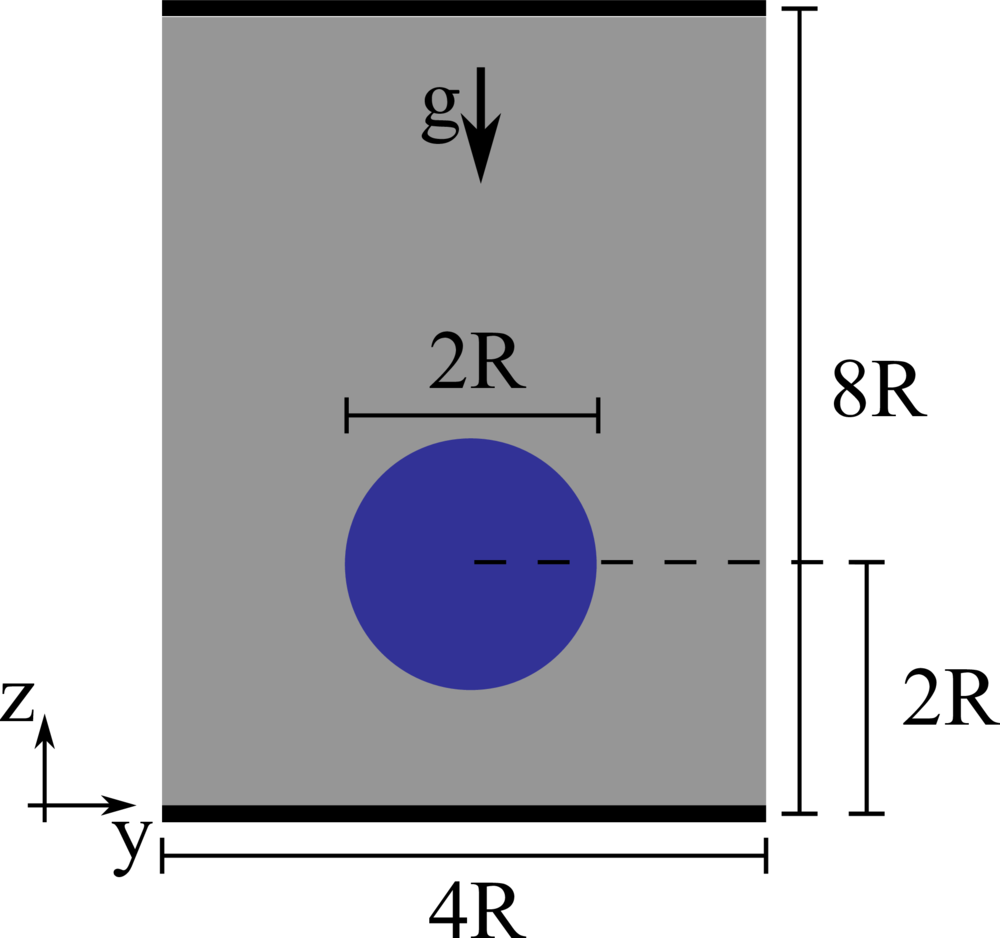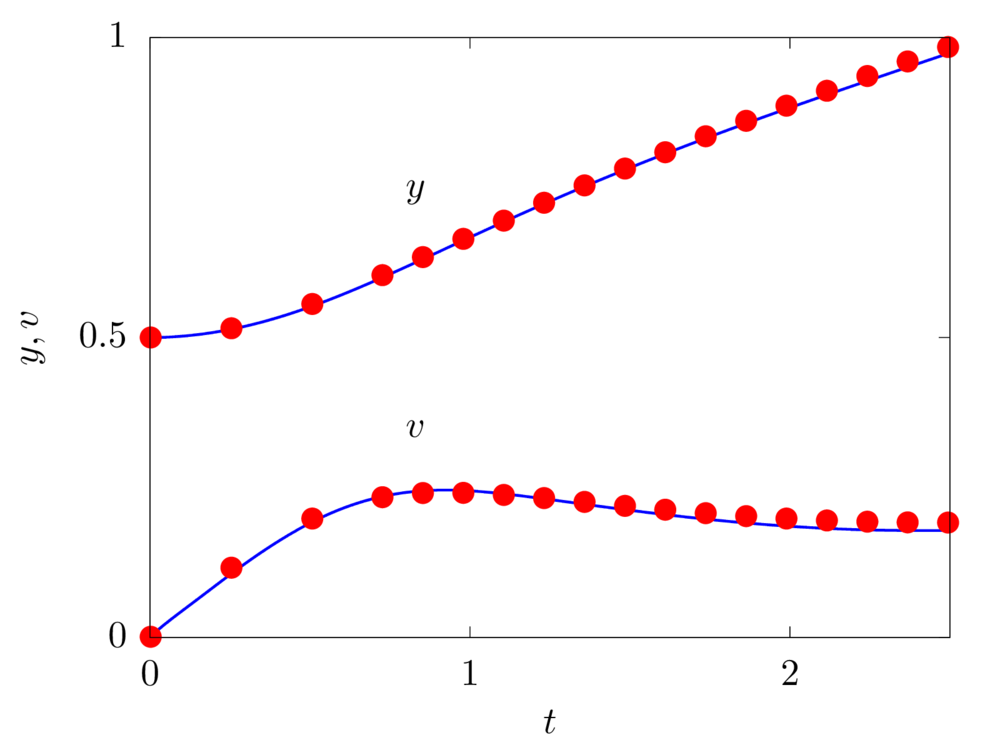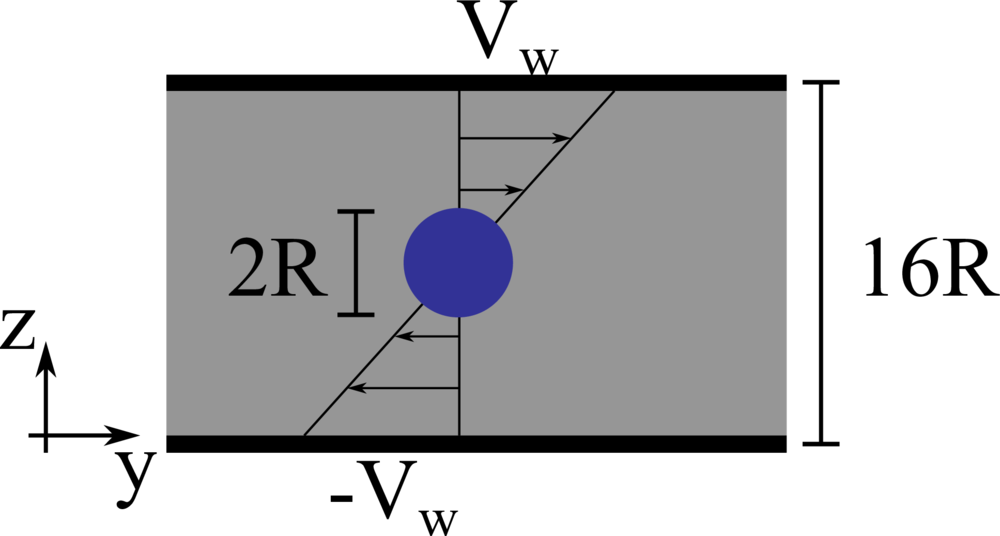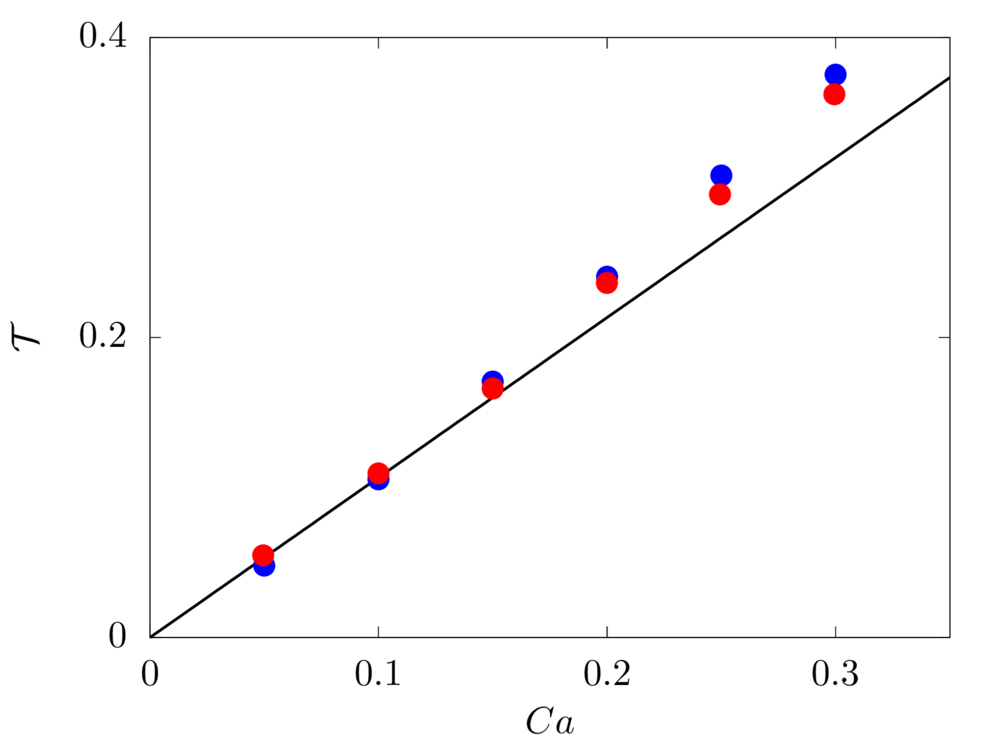Code - Fujin - Validation - Volume of Fluid
Zalesak's disk
The Zalesak’s disk [1], i.e., a slotted disk undergoing solid body rotation, is a standard benchmark to validate numerical schemes for advection problems, since the initial shape should not deform under rigid body rotation. We consider a domain of unit size with the slotted disk defined by the geometrical relation
\(\left( y -0.5 \right)^2 + \left( z - 0.75 \right)^2 \le 0.15^2 \wedge \left( \vert y - 0.5 \vert \ge 0.025 \vee z \ge 0.85 \right).\)
The velocity field is imposed equal to
\(v = 0.5 - z,\)
\(w = y - 0.5.\)
Numerical tests are carried out on three grids with \(100\), \(150\) and \(200\) grid points per side of the domain. The results are evalauted at \(t = 2 \pi\) (one revolution) and \(t = 10 \pi\) (five revolutions).
config.h
#define _FLOW_FIXED_ #define _MULTIPHASE_ #define _MULTIPHASE_VOF_ #define _MULTIPHASE_VOF_ZALESAK_ #define _MULTIPHASE_VOF_2D_ #define _MULTIPHASE_VOF_QUADRATIC_
param.f90
!Total number of grid points in X, Y and Z integer, parameter :: nxt = 4, nyt = 100, nzt = 100 !Size of the domain in X, Y and Z real, parameter :: lx = 4.0/100.0, ly = 1.0, lz = 1.0 !Output frequency integer,parameter :: iout0d = 1000000, iout1d = 1000000, iout2d = 1, iout3d = 1000000, ioutfld = 1000000
main.f90
! Simulation initial step iStart = 0 ! Simulation final step iEnd = 400000 ! Choose the timestep dt = 0.5/(2.0*0.5/(1.0/100.0))

Deformed interface in a shear flow
We study a deformed interface in a shear flow in order to evaluate the capability of the method to capture a heavily deformed and stretched interface [2]. We consider a circle of radius \(0.2 \pi\), centered at \(\left[ 0.5 \pi, -0.2 \left( \pi + 1 \right) \right]\) in a box of side \(\pi\) with the prescribed velocity field
\(v = \sin \left( y \right) \cos \left( z \right),\)
\(w = -\cos \left( y \right) \sin \left( z \right).\)
First, the interface deforms due to the imposed velocity field reaching its maximum stretching at \( t = 5 \pi\) when the flow is reversed. The interface deformation starts reducing and finally, at time \(t = 10 \pi\) the interface goes back to its initial position.
config.h
#define _FLOW_FIXED_ #define _MULTIPHASE_ #define _MULTIPHASE_VOF_ #define _MULTIPHASE_VOF_DROPLETS_ #define _MULTIPHASE_VOF_2D_ #define _MULTIPHASE_VOF_QUADRATIC_
param.f90
!Total number of grid points in X, Y and Z integer, parameter :: nxt = 4, nyt = 100, nzt = 100 !Size of the domain in X, Y and Z real, parameter :: lx = 4.0*ACOS(-1.0)/100.0, ly = ACOS(-1.0), lz = ACOS(-1.0) !Output frequency integer,parameter :: iout0d = 1000000, iout1d = 1000000, iout2d = 1, iout3d = 1000000, ioutfld = 1000000
main.f90
! Simulation initial step iStart = 0 ! Simulation final step iEnd = 400000 ! Choose the timestep dt = 0.0025*ACOS(-1.0)
initDropletPosition.dat
1.570796326794897 0.828318530717959 0.628318530717959

Buoyancy-driven flow

We consider a 2D droplet of radius \(R\) rising in a fluid with different density and viscosity. The droplet has viscosity \(\mu_1\) and density and \(\rho_1\), while the surrounding fluid has viscosity \(\mu_2\) and density \(\rho_2\), providing a viscosity and density ratio equal to \(k_\mu = 10\) and \(k_\rho = 10\). The two fluids are separted by an interface with interfacial surface tension \(\sigma\). The domain is rectangular with size \(4 R \times 8 R\), no-slip boundary conditions are applied on the horizontal walls and free-slip boundary conditions on the sides. The droplet is initially round and placed at the centerline of the channel at a distance of \(2R\) from the bottom wall. The non-dimensional parameters governing the flow are the Reynolds number \(Re = \rho_1 U_g 2 R / \mu_1\) equal to \(35\), the Eotvos number \(Eo = \rho_1 U_g^2 2R / \sigma\) equal to \(10\), and the Capillary number \(Ca = \mu_1 U_g / \sigma\) equal to \(0.2875\), where \(U_g = \sqrt{g2R}\) being \(g\) the gravitational acceleration.
config.h
#define _FLOW_COUETTE_ #define _SOLVER_FFT2D_ #define _MULTIPHASE_ #define _MULTIPHASE_VOF_ #define _MULTIPHASE_VOF_DROPLETS_ #define _MULTIPHASE_VISCOSITY_VARIABLE_ #define _MULTIPHASE_DENSITY_VARIABLE_ #define _MULTIPHASE_VOF_2D_ #define _MULTIPHASE_VOF_QUADRATIC_
param.f90
!Total number of grid points in X, Y and Z integer, parameter :: nxt = 4, nyt = 128, nzt = 256 !Size of the domain in X, Y and Z real, parameter :: lx = 4.0*1.0/128.0, ly = 1.0, lz = 2.0 !Fluid viscosity and density real, parameter :: vis = 10.0, rho = 1000.0 !Reference velocity (bulk velocity or wall velocity) real, parameter :: refVel = 0.0 !Gravitational acceleration real, dimension(3), parameter :: gr=(/0.0,0.0,-0.98/) !Output frequency integer,parameter :: iout0d = 100, iout1d = 10000, iout2d = 10000, iout3d = 10000, ioutfld = 10000 !Number of droplets integer, parameter :: vofN = 1 !Interfacial surface tension real, parameter :: vofSigma = 24.5 !Viscosity of the disphersed phase (phi=1) real, parameter :: vofVis1 = 1.0 !Viscosity of the carrier phase (phi=0) real, parameter :: vofVis2 = vis !Density of the disphersed phase (phi=1) real, parameter :: vofRho1 = 100.0 !Density of the carrier phase (phi=0) real, parameter :: vofRho2 = rho
main.f90
! Simulation initial step iStart = 0 ! Simulation final step iEnd = 9999999 ! Choose the timestep dt = 0.00001
initDropletPosition.dat
0.5 0.5 0.25


Droplet deformation in a shear flow

We consider a 3D spherical drop of radius \(R\) located at the center of a computational domain of size \(8R \times 16R \times 16R\), discretised with a resolution of \(20\) grid points per drop diameter. The top and bottom walls move with opposite velocity \(\pm V_w\), providing a shear rate \(\dot{\gamma} = 2 V_w/16R\), while periodic boundary conditions are imposed in the remaining directions. The same density and viscosity are specified for the spherical drop and the surrounding fluid, the Reynolds number \(Re = \rho \dot{\gamma} R^2/\mu\) is fixed to \(0.1\), and six capillary numbers are studied: \(0.05\), \(0.10\), \(0.15\), \(0.20\), \(0.25\) and \(0.30\).
config.h
#define _FLOW_COUETTE_ #define _SOLVER_FFT2D_ #define _MULTIPHASE_ #define _MULTIPHASE_VOF_ #define _MULTIPHASE_VOF_DROPLETS_ #define _MULTIPHASE_VISCOSITY_UNIFORM_ #define _MULTIPHASE_DENSITY_UNIFORM_ #define _MULTIPHASE_VOF_3D_ #define _MULTIPHASE_VOF_QUADRATIC_
param.f90
!Total number of grid points in X, Y and Z integer, parameter :: nxt = 80, nyt = 160, nzt = 160 !Size of the domain in X, Y and Z real, parameter :: lx = 4.0, ly = 8.0, lz = 8.0 !Fluid viscosity and density real, parameter :: vis = 0.5**2/0.1, rho = 1.0 !Reference velocity (bulk velocity or wall velocity) real, parameter :: refVel = 4.0 !Gravitational acceleration real, dimension(3), parameter :: gr=(/0.0,0.0,-0.0/) !Output frequency integer,parameter :: iout0d = 100, iout1d = 100000, iout2d = 20000, iout3d = 100000, ioutfld = 100000 !Number of droplets integer, parameter :: vofN = 1 !Interfacial surface tension real, parameter :: vofSigma = vis*0.5/0.05
main.f90
! Simulation initial step iStart = 0 ! Simulation final step iEnd = 9999999 ! Choose the timestep dt = 0.0001/2.0
initDropletPosition.dat
2.0 4.0 4.0 0.5


References:
[1] S. T. Zalesak. Fully multidimensional flux-corrected transport. Journal of Computational Physics, 31:335–362, 1979.
[2] M. Rudman. Volume-tracking methods for interfacial flow calculations. International Journal for Nu- merical Methods in Fluids, 24(7):671–691, 1997.
[3] S. R. Hysing, S. Turek, D. Kuzmin, N. Parolini, E. Burman, S. Ganesan, and L. Tobiska. Quantitative benchmark computations of two-dimensional bubble dynamics. International Journal for Numerical Methods in Fluids, 60(11):1259-1288, 2009.
[4] S. Ii, K. Sugiyama, S. Takeuchi, S. Takagi, Y. Matsumoto, and F. Xiao. An interface capturing method with a continuous function: the THINC method with multi-dimensional reconstruction. Journal of Computational Physics, 231(5):2328–2358, 2012.
[5] G. I. Taylor. The formation of emulsions in definable fields of flow. Proceedings of the Royal Society of London A: Mathematical, Physical and Engineering Sciences, 146(858):501–523, 1934.



